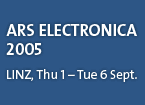 |
 |
 |
 |
 |
 |
Life after death, making surveillance cameras visible, and a stroll through an eerie landscape by night—a series of fascinating installations await visitors to the Ars Electronica Festival.
The CyberArts Exhibition in the O.K Center for Contemporary Art presents the winning works in the 2005 Prix Ars Electronica’s Interactive Art and Digital Musics categories. “Milkproject,” for which Ieva Auzina, Esther Polak and the Riga Center for New Media Culture were honored with a Golden Nica, utilizes GPS satellite navigation technology to show how milk makes its way from Latvian dairy farmers to Dutch consumers. The resulting digital map becomes an interface for the stories and the ways of life of the people involved in this logistical chain.
Mateusz Herczka’s project “Life Support Systems: Vanda” deals with the question of living on after death. All of life consists of information that can be saved to memory as electrical impulses. Storing all the impulses a creature needs to live would theoretically make it possible for it to live on in virtual space. In his installation, Herczka uses the electrical signals of the Vanda Hybridia orchid to produce a virtual organism.
"how long does the subject linger on the edge of the volume..." brings completely new dimensions to dance performance. Infrared cameras record the movements of the dancers and these images are then processed by a motion capture system. The movements are interpreted, whereupon the system begins to develop the choreography further.
The Ars Electronica Center is getting a youthful makeover. This is where the prizewinning works in the “u19 – freestyle computing” category for young people are going on display and their young creators singled out for recognition. “Lateral Thinking” tours for youngsters will provide a behind-the-scenes look at the festival and let participants get an impression of how media artists go about their work.
The Architekturforum Upper Austria and the Brucknerhaus are the venues on an exhibition entitled “Hybrid Creatures and Paradox Machines” that will showcase work currently being done by a number of artists on robotics, bionics and bio-engineering. The palette of creativity ranges from artistically constructed apparatuses all the way to ironic paraphrases and poetically useless machines.
The logo of this year’s festival comes from “Origin,” Daniel Lee’s series of images that will be exhibited in Linz’s Brucknerhaus. Lee depicts human evolution by means of a series of digitally processed images and animation, and thereby suggests the affinity of all forms of life—from fish to human being.
The similarity of two people’s pulses is established in the “Heart Beat” installation at the Ars Electronica Center. The degree of correspondence serves as the control signal of a visualization. The two subjects can achieve convergence by means of biofeedback sensors.
|
|
|

